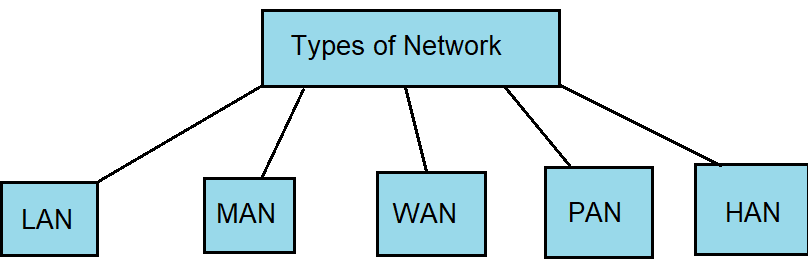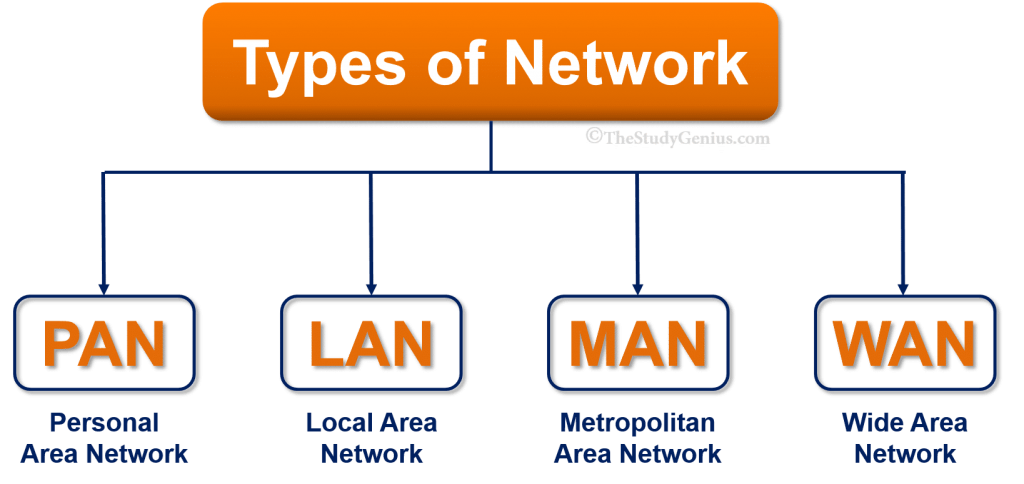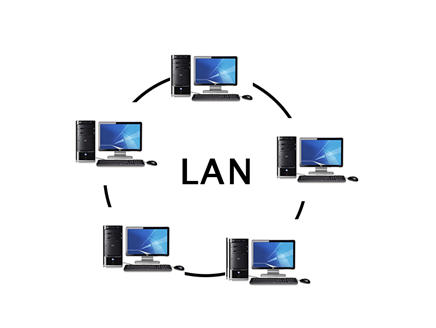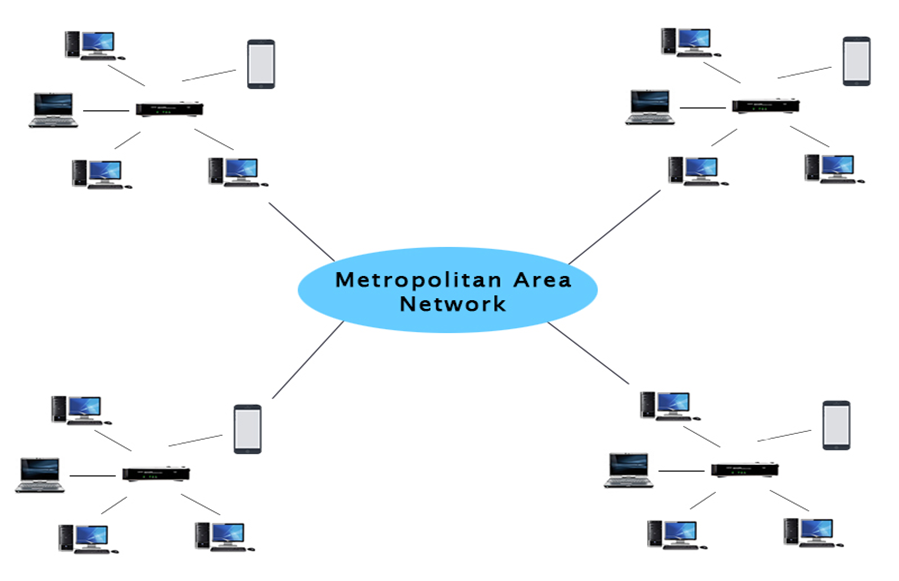What are the Types of Networks? A computer network is a collection of connected computers that allows one computer to talk with another to share resources, data, and programmes.
What is a computer network?
A computer network is a collection of computers connected by a common communication line that transfers resources from one computer to another that are offered by or kept on the network nodes.
Computer networks use in the following ways, for example:
- using instant chat, video, email, etc., to communicate
- sharing hardware like printers, scanners, etc.
- File exchange
- software and operating system sharing on distant platforms
- facilitating easy access to and maintenance of information for network users
A computer network can be classed based on its size. The four primary types of computer networks are as follows:
- LAN(Local Area Network)
- PAN(Personal Area Network)
- MAN(Metropolitan Area Network)
- WAN(Wide Area Network)
LAN(Local Area Network)
- A Local Area Network is a collection of interconnected computers in a constrained space, like an office or building.
- When two or more personal computers join by a communication media such as twist pair, coaxial cable, etc., it is known as a local area network (LAN).
- It is less expensive because hubs, network adapters, and Ethernet cables—cheap pieces of hardware—were used to build it.
- In a local area network, data is a discussion at a very rapid pace.
- A local area network offers greater security.
PAN(Personal Area Network)
- A network set up within a single person, often within a 10-metre radius, is called a personal area network.
- Personal area networks (PANs) connect personal computers and other electronic devices.
- The Personal Area Network was an idea that Thomas Zimmerman, a research scientist, initially introduced.
- Personal Area Network has a 30-foot radius.
- The laptop, mobile phone, media player, and play station are examples of personal computers used to build a private area network.
There are two types of Personal Area Networks:
- Wired Personal Area Network{WPAN}
- Wireless Personal Area Network{WPAN}
- Wireless Personal Area Network {WPAN}: Wireless Personal Area Network create using only wireless technologies like WiFi and Bluetooth. Therefore, it is a network with a limited range.
- Wired Personal Area Network: The USB establishes a wired personal area network to the new technology.
Examples Of Personal Area Networks:
Body Area Network: A network that moves with a person is called a body area network. A mobile network follows a person, for instance. Let’s say someone connects to a network and then joins a device to another device to share information.
Offline Network: A home network is also referred to as an offline network because it establishes there. A home network to link gadgets like printers, computers, and televisions—but not online ones.
Small Home Office: It utilizes to establish a VPN connection between several devices and the internet and a corporate network.
MAN(Metropolitan Area Network)
- A metropolitan area network connects various LANs to create a more extensive network that serves a greater geographic area.
- To communicate with the public and business sectors, government organizations use MAN.
- In MAN, a telephone exchange line connects several LANs.
- RS-232, Frame Relay, ATM, ISDN, OC-3, ADSL, and other frequently used protocols in MAN include.
- Its range is greater than that of a Local Area Network (LAN).
Uses Of Metropolitan Area Network:
- The banks in a city communicate through MAN.
- It can apply to an airline reservation.
- It can apply to a city college.
- Additionally, I can use it for military communication.
WAN (Wide Area Network)
- A Wide area network spans a lot of land, such as many states or entire nations.
- A Wide area network is far more extensive than a local area network.
- A Wide area network (WAN) connects multiple locations over an extensive geographic area using a phone line, fibre optic cable, or satellite links.
- Among all WANs, the internet is one of the largest.
- Businesses, government, and education all make extensive use of wide-area networks.
Examples Of Wide Area Networks:
Mobile broadband: A 4G network commonly throughout a region or a country.
A telecom operator uses the last mile to offer internet services to clients in hundreds of towns by connecting their homes with fibre.
Private network: A bank provides a private network linking 44 offices. The telecom company’s telephone leased line to build this network.
Advantages of Wide Area Networks:
The following benefits of the Wide Area Networks:
Geographical coverage: A wide-area network offers a broad geographic range. Let’s say we can connect to the branch of our office over WAN, even if it is in a different city. We can link with another component via the internet’s leased line.
Data centralization: When it comes to WAN networks, data centrally locates. Therefore, we do not need to purchase email, file, or backup servers.
Get updated files: On the live server, software businesses operate. As a result, the updated files are available to the programmers in seconds.
Exchange messages: quickly in a WAN network. You can contact friends via web applications like Facebook, Whatsapp, and Skype.
Software and resource sharing: We can exchange software and other resources like a hard drive and RAM in WAN networks.
Global commerce: We can conduct international business online.
High bandwidth is available if our business uses leased lines. The high bandwidth speeds up data transfer, which boosts our business’ productivity.
Disadvantages of Wide Area Network:
The Wide Area Network has the following drawbacks:
Security issue: A WAN network has more security concerns than a LAN or MAN network since all of the technologies are combined to produce the security issue.
It needs antiviral software and a firewall: Data transport across the internet, where hackers have the potential to alter or hack it. In addition, antivirus software is re
High setup costs: Since must purchase routers and switches, the WAN network installation is expensive.
Troubleshooting issues: It is challenging to solve because it affects a vast area.
Internetwork
An internetwork is a computer network with two or more LANs, WANs, or network segments connected by devices and set up with a local addressing system. Internetworking is the name given to this procedure.
- Internetworking connects public, private, commercial, industrial, or governmental computer networks.
- The internet protocol in internetworking.
- Open System Interconnection is the internetworking reference model (OSI).
Types Of Internetwork:
- Extranet: An extranet is a communication network base on internet protocol, such as the Transmission Control protocol and internet protocol. It works for information sharing. Only users with login credentials are allowed access to the extranet. The most fundamental level of internetworking is an extranet. It can classify as a MAN, WAN, or other types of computer network. A minimum of one link to the outside network requires an extranet; it cannot have just one LAN.
- Intranet: An intranet is a private network that uses internet protocols like Transmission Control protocol and internet protocol as its foundation. Only the employees or members of an organization’s organization have access to its intranet. Therefore, the intranet’s primary goal is to share knowledge and resources among the organization’s staff. In addition, group collaboration and teleconferences are made possible via intranets.
Intranet advantages:
Communication: It makes communication simple and affordable. Email and chat are two ways that an employee of the company might get in touch with another employee.
Saving time is possible since information on the intranet communicates instantly.
Collaboration: One of the most significant benefits of the intranet is collaboration. The data is shared among the company’s personnel and is only accessible to those permitted to do so.
Platform independence: This architecture is impartial because it allows for the connection of computers to devices with various architectural designs.
Cost-effective: The intranet is to disseminate duplicate copies of the data and documents, which are accessible via a browser. Due to this, the price decreases.
Other Types of Computer Networks
Apart from the computer mentioned above networks, here are some other important types of networks:

- WLAN (Wireless Local Area Network)
- Storage Area Network
- System Area Network
- Home Area Network
- POLAN- Passive Optical LAN
- Enterprise private network
- Campus Area Network
- Virtual Area Network
Conclusion:
With the least amount of overhead, a good network increases innovation, security, and productivity. Only a solid design and implementation based on an understanding of the business’s demands can achieve this. What are the Types of Networks, Even though building a network might appear like a technical task, it also involves commercial input, especially in the beginning. Along with changing technologies, network management also requires increasing and evolving workflows.
Also read: What is the Difference Between LAN MAN WAN











GIPHY App Key not set. Please check settings